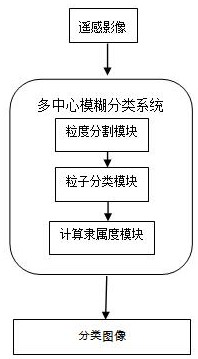Remote sensing image fuzzy multi-center supervised classification method and application
A technology for supervised classification, remote sensing imagery, applied in character and pattern recognition, instruments, computer parts, etc., and can solve problems such as limited accuracy
- Summary
- Abstract
- Description
- Claims
- Application Information
AI Technical Summary
Problems solved by technology
Method used
Image
Examples
Embodiment 1
[0031] Let the method use the data set as X, and generate particles directly through the unlabeled hierarchical clustering process. Thus, samples with similar spectral properties occur in a given particle. This hierarchical clustering procedure generates a cluster tree, and then uses labeled samples to classify leaves into three types: pure leaves, impure leaves, and unlabeled leaves. Considering the centers of pure leaves as multiple centers of land cover types, the degree of membership of an unlabeled sample within an impure particle nucleus unlabeled particle is determined by the shortest distance between the sample and the multiple centers. Detailed process such as figure 1 Shown:
[0032] 1. Granularity segmentation module
[0033] To model first- and second-order spectral diversity, the entire dataset is decomposed into particles of similar size in spectral space. On the basis of the FCM algorithm, a hierarchical clustering method using weighted Euclidean distance is...
PUM
 Login to View More
Login to View More Abstract
Description
Claims
Application Information
 Login to View More
Login to View More - R&D
- Intellectual Property
- Life Sciences
- Materials
- Tech Scout
- Unparalleled Data Quality
- Higher Quality Content
- 60% Fewer Hallucinations
Browse by: Latest US Patents, China's latest patents, Technical Efficacy Thesaurus, Application Domain, Technology Topic, Popular Technical Reports.
© 2025 PatSnap. All rights reserved.Legal|Privacy policy|Modern Slavery Act Transparency Statement|Sitemap|About US| Contact US: help@patsnap.com



